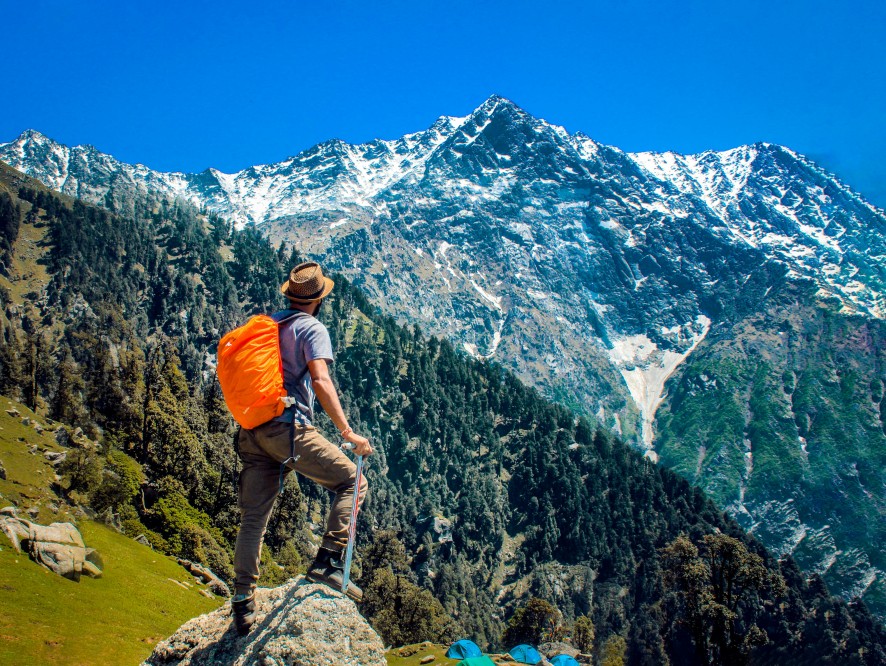The Kuari Pass Trek offers year-round adventure through varying landscapes and weather patterns, allowing trekkers to enjoy a different experience each season. Known for its breathtaking views of the Nanda Devi and Dronagiri peaks, this trek is an ideal option for nature lovers and adventurers alike.
Spring (March to April): A Fresh Start to the Trekking Season
Spring brings an enchanting freshness to the Kuari Pass Trek, as flowers bloom and greenery emerges, creating a vibrant path through the mountains. During these months, daytime temperatures are comfortably cool, ranging between 10°C and 15°C, making it an ideal time for those looking to explore the trek without harsh weather.
In spring, the trails are alive with colorful blossoms and fresh foliage. Snow lingers at higher altitudes, adding a beautiful contrast to the green valleys below. The spring season also allows trekkers to experience melting snow in rivers and waterfalls, making the scenery especially dynamic. It’s a fantastic time for those who enjoy trekking in mild conditions, with some residual snow adding a sense of adventure.
Spring Highlights:
- Pleasant temperatures and fresh mountain air.
- Colorful trails adorned with wildflowers and new leaves.
- Melting snow creating beautiful river flows and small waterfalls.
Summer (May to June): Peak Season for Trekkers
During the summer months of May and June, Kuari Pass is at its most accessible and is considered the peak season for trekking. Daytime temperatures range from 15°C to 20°C, making it an ideal season for comfortable trekking. This period offers clear skies, long days, and stable weather, providing excellent conditions for hiking, camping, and sightseeing.
The snow from winter has usually melted by June, making the trails easier to navigate. The valleys and meadows are lush, while panoramic views of peaks like Nanda Devi, Kamet, and Trishul are clear and striking. With favorable weather and blooming greenery, summer is perfect for trekkers looking to enjoy a straightforward and scenic experience.
Summer Highlights:
- Clear skies and warm temperatures.
- Snow-free trails, ideal for beginners and experienced trekkers.
- Stunning, unobstructed views of Himalayan peaks.
Monsoon (July to September): A Season of Rain and Renewal
The monsoon season from July to September is generally not recommended for the Kuari Pass Trek due to heavy rainfall, which can make the trails slippery and prone to landslides. The region experiences consistent rain during these months, turning the trails muddy and obstructing views with frequent clouds and fog.
However, the monsoon transforms the landscape, making the valleys greener than ever. This season is more suitable for experienced trekkers who are comfortable with challenging, rain-soaked trails. Those venturing during the late monsoon period may catch a break in the weather as the season winds down in early September.
Monsoon Highlights:
- Verdant landscapes with dense, lush vegetation.
- An opportunity for solitude with fewer trekkers.
- Challenging conditions, best suited for experienced trekkers.
Autumn (October to November): Golden Landscapes and Crisp Air
Autumn is another ideal time to embark on the Kuari Pass Trek, as the post-monsoon season offers clear skies, cool temperatures, and dry trails. From October to November, daytime temperatures range between 10°C and 15°C, while nights become significantly colder, especially in the higher altitudes.
This season is marked by golden hues as the foliage begins to change, offering trekkers a breathtaking mix of autumn colors against the stark mountains. With fewer crowds compared to summer, autumn also provides a tranquil and peaceful trekking experience. As the season progresses, temperatures drop, making it essential to bring warm gear for the colder nights.
Autumn Highlights:
- Crisp, clear weather with vibrant autumn foliage.
- Fewer crowds, offering a peaceful trekking experience.
- Stunning views and dry trails, ideal for photography.
Winter (December to February): A Snowy Wonderland
For those who enjoy winter trekking, December to February transforms Kuari Pass into a winter wonderland. During this season, the region is covered in snow, offering a challenging yet rewarding experience for trekkers willing to brave the cold. Daytime temperatures can hover around 0°C, while nighttime temperatures often dip below freezing.
Winter trekking on Kuari Pass requires preparation for icy paths and frigid conditions. However, the reward is an enchanting snow-covered landscape with awe-inspiring views of Himalayan peaks. Winter trekkers often find solitude, as fewer adventurers brave the cold during this period.
Winter Highlights:
- Snow-covered landscapes with breathtaking mountain views.
- A quiet, secluded trekking experience with fewer crowds.
- Opportunities for snow trekking and winter camping.
Conclusion: Choosing the Best Season for Your Kuari Pass Trek
The Kuari Pass Trek is accessible across various seasons, each offering unique aspects for every type of trekker. Spring and autumn provide comfortable trekking weather with scenic landscapes, while summer offers the most accessible trails with vibrant greenery. For those seeking solitude and winter trekking adventure, the colder months provide a snowy retreat with incredible mountain views.
No matter when you decide to go, Kuari Pass promises an unforgettable journey through some of Uttarakhand’s most stunning and diverse landscapes.
